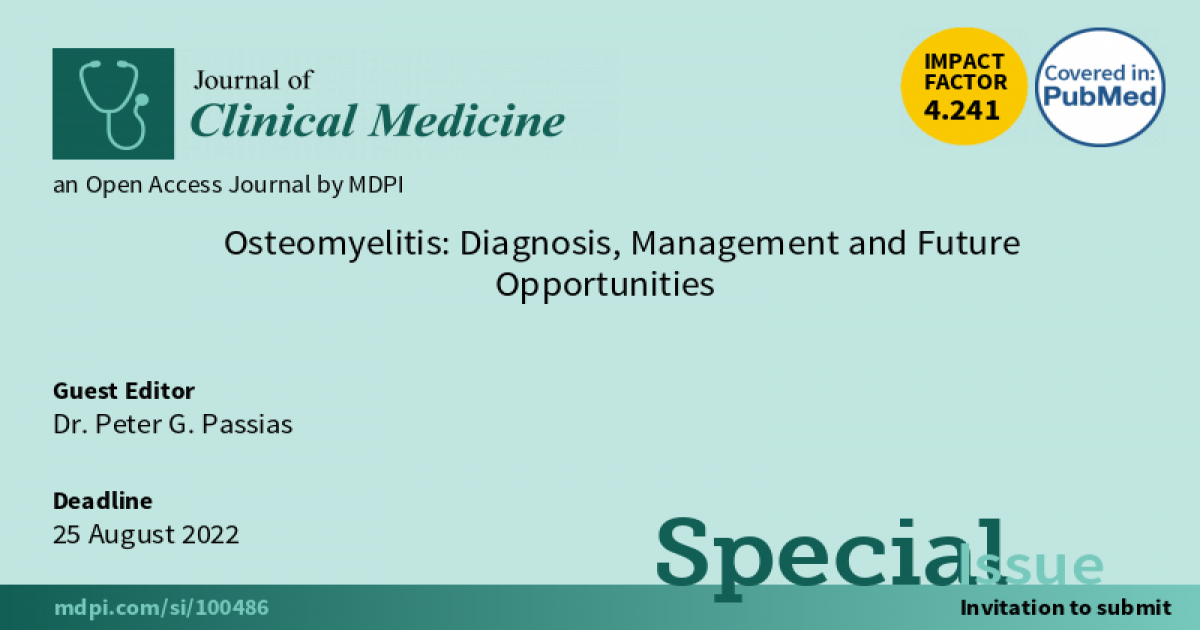Osteomyelitis: Diagnosis, Management and Future Opportunities
A special issue of Journal of Clinical Medicine (ISSN 2077-0383). This special issue belongs to the section "Orthopedics".
Deadline for manuscript submissions: closed (25 August 2022) | Viewed by 4932

Special Issue Editor
Interests: orthopaedic surgery; lordosis; kyphosis; spinal cord diseases
Special Issues, Collections and Topics in MDPI journals
Special Issue Information
Dear Colleagues,
It is my pleasure to present this Special Issue of the Journal of Clinical Medicine on “Osteomyelitis: Diagnosis, Management, and Future Opportunities.” The purpose of this issue is to investigate the clinical management of osteomyelitis, an infection of the structural components of the musculoskeletal system that can present in adults or children, especially those with particular risk factors. The nonspecific presenting symptoms such as localized pain, swelling, and fever bespeak the intricacy of the diagnosis and necessitate correlation with advanced diagnostic imaging. Management depends on the extent and characterization of the infection, with long-term broad spectrum antibiotics being an essential component in the mainstay of treatment options. Surgical intervention may be required to debride dead bone and surrounding tissue to prevent further spread or reinoculation. The increasing knowledge about the pathophysiology and treatment outcomes will further allow us to risk stratify those with osteomyelitis and properly regulate their condition.
Dr. Peter G. Passias
Guest Editor
Manuscript Submission Information
Manuscripts should be submitted online at www.mdpi.com by registering and logging in to this website. Once you are registered, click here to go to the submission form. Manuscripts can be submitted until the deadline. All submissions that pass pre-check are peer-reviewed. Accepted papers will be published continuously in the journal (as soon as accepted) and will be listed together on the special issue website. Research articles, review articles as well as short communications are invited. For planned papers, a title and short abstract (about 100 words) can be sent to the Editorial Office for announcement on this website.
Submitted manuscripts should not have been published previously, nor be under consideration for publication elsewhere (except conference proceedings papers). All manuscripts are thoroughly refereed through a single-blind peer-review process. A guide for authors and other relevant information for submission of manuscripts is available on the Instructions for Authors page. Journal of Clinical Medicine is an international peer-reviewed open access semimonthly journal published by MDPI.
Please visit the Instructions for Authors page before submitting a manuscript. The Article Processing Charge (APC) for publication in this open access journal is 2600 CHF (Swiss Francs). Submitted papers should be well formatted and use good English. Authors may use MDPI's English editing service prior to publication or during author revisions.
Keywords
- osteomyelitis
- inflammation
- antibiotics
- staphylococcus aureus
- septic
- surgical debridement
- infection
- reconstructive fusion
- corpectomy
Benefits of Publishing in a Special Issue
- Ease of navigation: Grouping papers by topic helps scholars navigate broad scope journals more efficiently.
- Greater discoverability: Special Issues support the reach and impact of scientific research. Articles in Special Issues are more discoverable and cited more frequently.
- Expansion of research network: Special Issues facilitate connections among authors, fostering scientific collaborations.
- External promotion: Articles in Special Issues are often promoted through the journal's social media, increasing their visibility.
- e-Book format: Special Issues with more than 10 articles can be published as dedicated e-books, ensuring wide and rapid dissemination.
Further information on MDPI's Special Issue polices can be found here.






